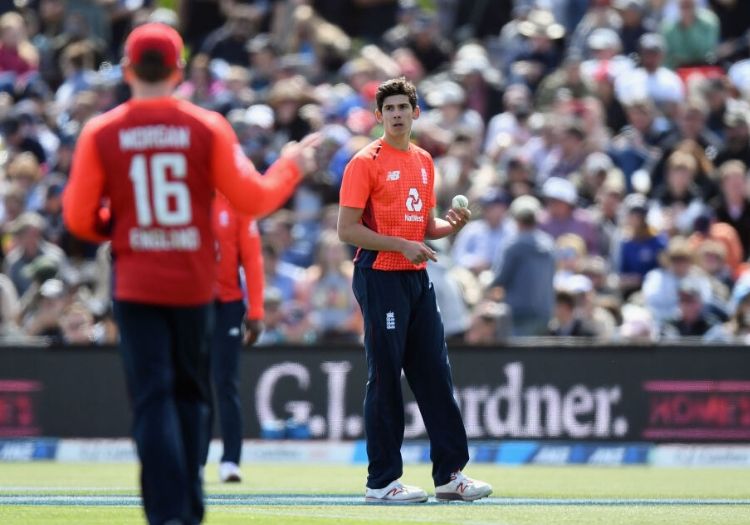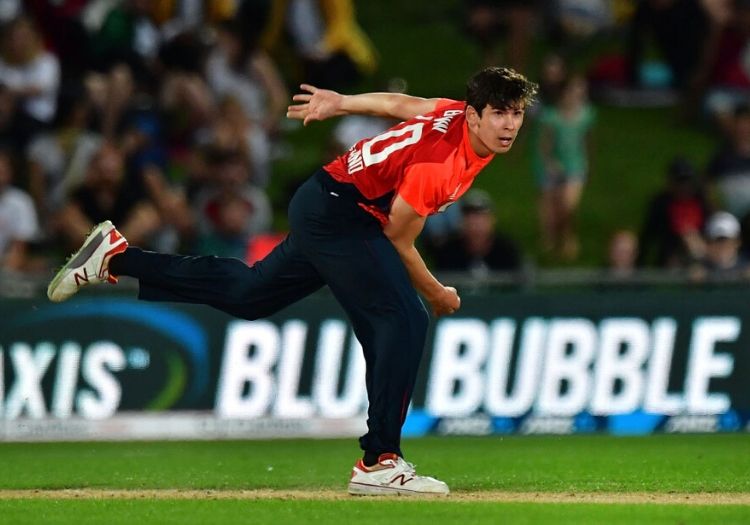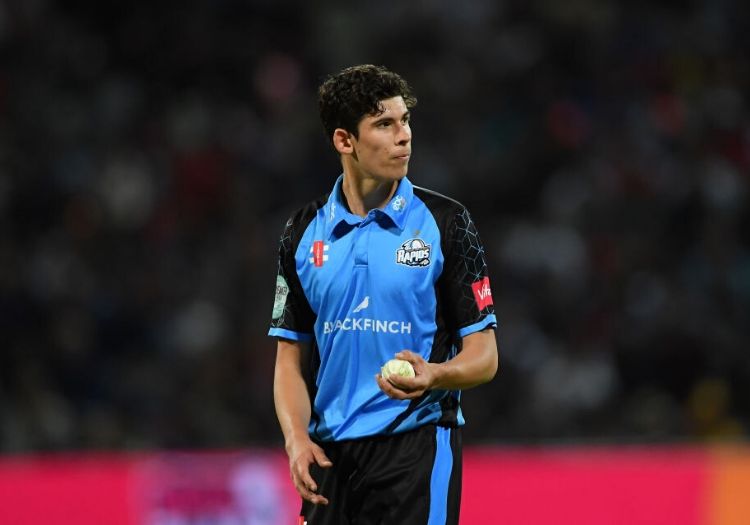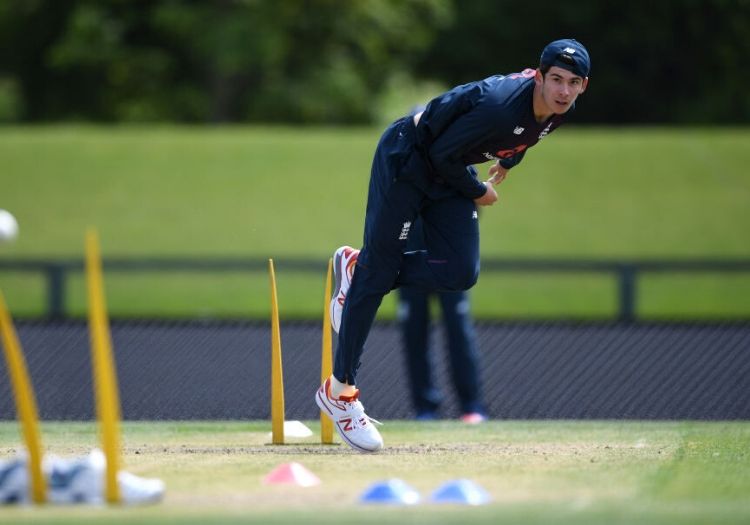NICK FRIEND: The youngster has endured a tough couple of months; a back injury ruled him out of the Big Bash and two South Africa series. But Brown is intelligent and candid on those frustrations and insightful on what he learnt from his England bow

On the youthful frame of Pat Brown, there sits a wise head. He has needed it in the last two months.
A landmark winter began with an England debut in New Zealand and was meant to be followed by a Big Bash stint with Melbourne Stars, before finishing off in South Africa as part of Eoin Morgan’s white-ball juggernaut.
Instead, it ended with a frustrating sense of déjà vu – a second stress fracture in as many winters and no chance to add to four caps earned in November. The first time, the injury prevented his involvement in the Bangladesh Premier League with Sylhet Sixers.
This setback, however, has hurt more, even if Brown reflects on the reoccurrence of his back problem with a philosophical maturity; it is part and parcel of life as a fast bowler, he knows.
“I think in 2018 it was slightly different because I already knew that I wasn’t going to be fit for that, so I didn’t have something taken away from me,” he says.
“This time around, I was obviously meant to play for the Stars and then they got to the final as well, so it would have been amazing to play at the MCG.
“And then I missed both ODI and T20 legs of the England tour as well, so this time it felt like I had something and it was taken away from me by injury. It was a bit more disappointing, but it’s one of those things.”
Brown is engaging company and an impressive young man; that’s hardly news. Few force their way into an England squad with seven first-class wickets to their name, but then there have been few English cricketers with his range of skills. Having had a taste of international cricket, there is a genuine sense of disappointment that further opportunities have, for the moment, been snatched away.
“It feels like you’re on trial in your first couple of tours and first games,” he explains, “so, to miss that chance to impress is a bit annoying, especially so close to the World Cup. But I’m only 21 years old. If I continue to bowl well, I’m sure there’ll be more World Cups in the future.
“I suppose my focus now has switched from being in the squad to being the first man in if someone else unfortunately gets injured like I did. My focus has to be to perform for Worcester and in The Hundred; I want to be the first man in, if that makes sense.”
It makes perfect sense. It is how he first entered the thoughts of England, Melbourne, Sylhet and, latterly, Birmingham Phoenix – through a sheer weight of wickets, variations and match-winning displays for his county.
The 21-year-old was only ever due to feature in the second half of the Big Bash season, with Dale Steyn playing the first six games as one of two overseas players. Yet, Brown flew out for the start of the tournament to work with Glenn Maxwell’s squad, only for the issue to flare up during a training session in Hobart.
“It had been sore for a couple of months, but I thought it wasn’t as bad as it was,” he admits, speaking to The Cricketer at the launch of the ECB’s Dynamos Cricket initiative.
“I had one session in Australia and it was like my back had decided that it had had enough and didn’t want to bowl in pain anymore.
“It basically told me in no uncertain terms that I needed to stop and have this looked at.
“I had one last winter as well, so I kind of know the process. It wasn’t that heartbreaking or upsetting because I had a feeling that was what it was, so I knew the timescale of what I’d have to go through.”

Only Stuart Broad of the 34 seamers to represent England in T20Is made his debut when younger than Brown
The bottom line is that the Worcestershire seamer doesn’t expect to be fit for the start of the campaign, perhaps not even until June.
In a sense, it is a sobering way to end a special period for a huge talent; of the 34 seamers to have represented England in T20Is, only Stuart Broad made his debut younger.
It shows the esteem in which Brown is held; on his international bow, he bowled the 16th and 20th overs in a seven-wicket victory at Christchurch. Rather than drip-feeding him into the action, he was asked to replicate what he does on a regular basis for Worcestershire. Nobody has taken more wickets in the last two T20 Blast campaigns than his 48.
“You get used to bowling in that role and you get used to the dynamics of the game and that period,” he says. “To be asked to do something completely different is quite difficult, so to be trusted to do what I do for Worcester for England was quite nice.
“I know it’s probably the hardest thing to do in terms of the role you play, but I think it’s important as a bowler that you are bowling at the same times as you would normally.”
In the last two years, Brown has claimed 29 wickets in the final five overs of innings in domestic T20 cricket; only nine men have taken more – none at a better strike-rate than his 9.31 and only three (Imran Tahir, Faheem Ashraf and Rashid Khan) at a stingier economy. Even so, he confesses to feeling a sense of wonder as he took his place in an England changing room for the first time.
“It was the first white-ball cricket since the victory in the World Cup, so to walk in under Eoin Morgan, who’s an unbelievable captain, and to walk into his changing room as a relative unknown was quite an experience.
“It’s something I’ll look back on very fondly. The whole New Zealand experience – just being around the camp and, obviously playing – was just amazing. Now that I’m injured, suddenly thinking about that is driving me on to try to get back into it.”
Brown’s respect for Morgan is instantly visible from his expression even before it becomes audible. With Moeen Ali, his county colleague, not part of the touring party and ten of the squad hailing from the T20 Blast’s South Group, there was no glut of familiar faces for Brown to latch onto.
Yet, the environment created by England’s white-ball captain, he reflects, made the transition easier. In Moeen’s leadership style at Worcestershire, he can now see elements of the dynasty forged by Morgan.

Brown bowled Worcestershire to the T20 Blast title in 2018 and almost repeated the trick a year later
“Mo’s style as captain is very similar to Eoin’s – I imagine he’s learnt that from him,” Brown says. “It was very relaxed and a style of captaincy that I feel like I thrive under. It wasn’t too intense; it was mainly just a case of having a plan and backing it.
“If you’ve got a plan and the right field and you try to execute the right ball, he’s happy. He knows that things can go wrong – you can bowl the perfect ball and it can get hit for six.”
In a series dominated by batsmen – ten separate bowlers conceded their runs at an economy upwards of nine runs per over, Brown recognises how much he learnt.
“It is daunting,” he laughs. “I think the main issue is that guys in international cricket hit it even further than guys in domestic cricket.
“When it’s a 40-yard boundary, I remember with someone like Colin de Grandhomme – two or three times I bowled a slower ball and did him. I knew I’d done him, but he still gets it for six.
“I’m stood there thinking: ‘What can I do? I’ve actually done him there but it’s still gone for six.’ That sort of thing makes you think that I need to go for the hole here and find a way to get him off strike.”
The surfaces were hardly forgiving – he was involved at Napier as England racked up 241, while Martin Guptill and de Grandhomme took him down at Wellington. It is the nature of the T20 beast.
There is a refreshing candour to Brown, though, and he is a resilient character. You have to be as a burgeoning presence on the short-form circuit, where stocks rise and fall almost simultaneously. He is the first to acknowledge his limitations; after all, he only made his professional debut in 2017 and he is still learning his trade.
That he has made it so far already is testament to the quality of the skillset he has built up in a short space of time.
His knuckleball has rightly come in for regular praise – not least in the Blast, where he has taken 7 for 85 from 16 overs across the last two Finals Days. His other deliveries, therefore, have gone under the radar somewhat; his ‘stock’ delivery – if Brown possesses such a thing – is hardly slow, while his off-cutter is equally effective. Nevertheless, he knows he needs more.
“I knew before going out to New Zealand that there were certain things I needed to work on,” he stresses. “Probably powerplay bowling being one thing, in terms of being able to take wickets in the powerplay rather than just stemming the flow, which I’ve been pretty good at.
“And then there’s also having another dimension at the death, where you can go blockhole. I already knew that, but on those boundaries and those pitches, it was amplified even more but that’s just what you’ve got to go through.”

Pat Brown's first international wicket was that of Ross Taylor
At this early stage of his career, he has taken just 14 wickets in the powerplay. He has actually bowled more deliveries in the final five overs than the first six, claiming 30 scalps at a superior economy rate – 8.2 – than at the start of the innings – 8.6.
For context, of course, Brown has played just 40 T20 matches in his career; only a few months ago, he graduated with a 2:1 in business studies from the University of Worcester. He is 310 appearances behind Ravi Bopara, the English record-holder in the format.
And yet, Wayne Parnell apart, he is the senior statesman of Worcestershire’s T20 fast bowling stocks. It is a job he relishes – an unusual post for one so young, but symbolic both of his own excellence and his county’s philosophy of growth from within.
“He goes about his business in his own sort of way,” his Worcestershire teammate Dillon Pennington told The Cricketer. “He chats to everyone, but he thrives off being really, really competitive.
“He’s learned a lot about T20, so I chat for ages to him about it and how he goes about it and how he deals with the pressures around it.”
“I know when I go away that I want to bring as much back to Worcester as I can,” Brown adds. “We’ve obviously had good success over the last two years and a lot of that has been based on communication and having good plans beforehand and backing each other.
“I was always keen to learn as much as I could and bring it back to Worcester. It is slightly weird being a 21-year-old and feeling like I’m almost the most experienced in that attack now. But it’s a role I quite enjoy and take on quite naturally.”
And it is why, perhaps, the disappointments of September’s Blast final defeat were so quickly brushed off. “Sometimes, you just have to look back and hold your hands up,” he reflects. There is an image of Brown leaving the Edgbaston turf crestfallen after Simon Harmer hit the winning runs to deny his Rapids side a second successive title. Five months on, that feeling has long since passed. He offers a wry, thoughtful smile even at its mention.
“It wasn’t hard to get past because we knew we had good plans and it was literally the case of one guy having a phenomenal day. I suppose I had the day he had last year in 2018, in comparison.
“He was the first guy all day who came in and struck it cleanly from ball one. He hit my first ball for four when he came in (the penultimate ball of Brown’s spell in the 19th over of Essex’s chase).
“I look back and think whether I should have bowled that ball or whether I should have gone hole or something. Sometimes, you have to just hold your hands up and have confidence that you did the right thing.
“I think that’s why it was quite an easy loss to take. We knew we’d done the right things and it had just been taken away from us.”
A wise head on young shoulders, Pat Brown will come again.